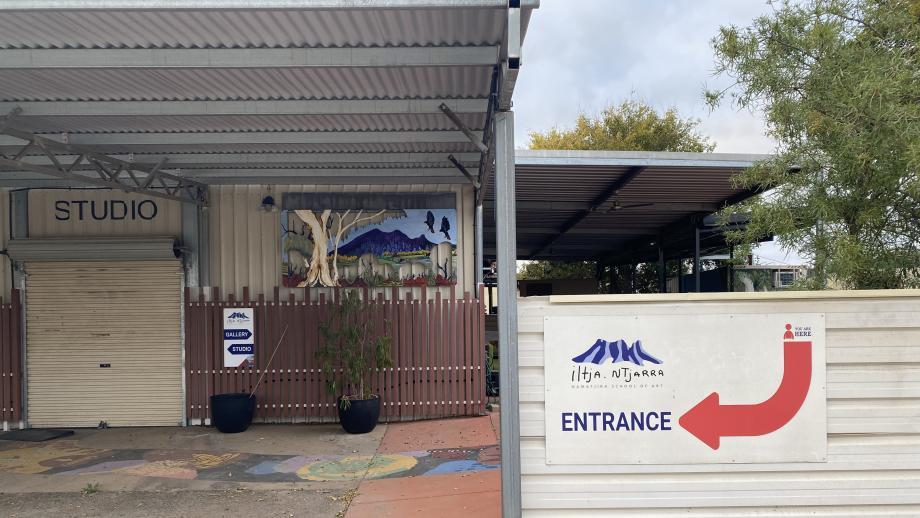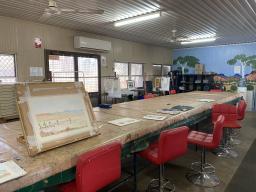
Iltja Ntjarra Art Centre and Gallery, Alice Springs.
By Dr Emily Gallagher
In late June I had the privilege of spending several days on Arrernte Country in Central Australia. It was the last adventure for my book, Playtime, which comes out later this year with La Trobe University Press. The book is a history of Australian childhood and it takes an unusual approach in that it relies to a large extent on the writings, drawings and creative work of children themselves.
I have travelled widely over the last few years in an effort to locate child-authored materials in different parts of the country, but one of the more remarkable collections that I have come across is in fact held closer to home. The Frances Derham Collection at the National Gallery of Australia comprises around four thousand artworks that were completed by children from around the world in the mid-twentieth century. Within that immense collection are four hundred or so pencil and crayon drawings by children who were at the Finke River Lutheran Mission at Ntaria (Hermannsburg) in 1938-9. It is perhaps the most significant collection of First Nations child art in Australia from the pre-1945 period.
When I first saw these drawings at the Gallery’s off-site facility six years ago, they ignited in me a desire to see Tjoritja (West MacDonnell Ranges) for myself. It has taken a couple of years, but with the generous support of the Minoru Hokari Memorial Scholarship, I finally had the opportunity to make my way to Mparntwe (Alice Springs).
Nothing ever goes entirely to plan on fieldwork, and this trip was all the better for it. I am indebted to the Iltja Ntjarra Art Centre for offering me a helping hand, especially their studio coordinator Tyler Arnold, who let me take the passenger seat for his weekly trip to the Tjuwanpa studio at Ntaria. There we spent a day painting with Marcus Wheeler, a senior law man and pastor, and his wife Betty, who was taught watercolours by her grandfather Albert Namatjira. We spread out copies of the children’s drawings on the tables and a few local workers and residents wandered in to see them. Remembering the Old People who lived at Ntaria when they were young, Marcus and Betty generously helped to identify many of the Arrernte child artists who had only signed their drawings with their first names. We soon learned that one drawing in the collection belonged to Betty’s mother.
It has always seemed important to me that these artworks be properly attributed and connected back to their families, who are very often also copyright holders. For too long they have sat in storage in Canberra and a great deal more work needs to be done to return them to Iltja Ntjarra and the community. The fact that the artists were children should not diminish the importance of these drawings as works of art—one thing we can admire about Frances Derham is the way she fought to have children’s art and creativity taken seriously. For better or worse, it is no accident that her collection is held at the nation’s premier art gallery.
The story of the child artists at the Finke River Lutheran Mission is one that enriches and broadens our understanding of the Hermannsburg Art Movement. While scholars have recognised that many of the most prominent Hermannsburg artists were first introduced to watercolour and landscape painting as children – whether by visiting artists or members of their own community – they have rarely been given attention in the history of that movement. Instead, there is often a clear distinction made between drawing as a child and beginning to paint ‘seriously’ in adulthood (e.g. exhibiting and selling). This is no doubt partly due to the importance placed on art as a source of economic security and stability for the Western Arrernte community.
My research sets out to complicate that distinction: to treat children’s creative work seriously and recognise its importance as a form of meaning making and self-expression. Part of what I hope my book will do is deepen our understanding of the way culture and Country framed and enriched children’s creativity and imaginative life. Certainly, the Arrernte drawings in the Derham collection survive as a powerful tribute to the way First Nations children sometimes used art to navigate colonisation and preserve their own culture.

